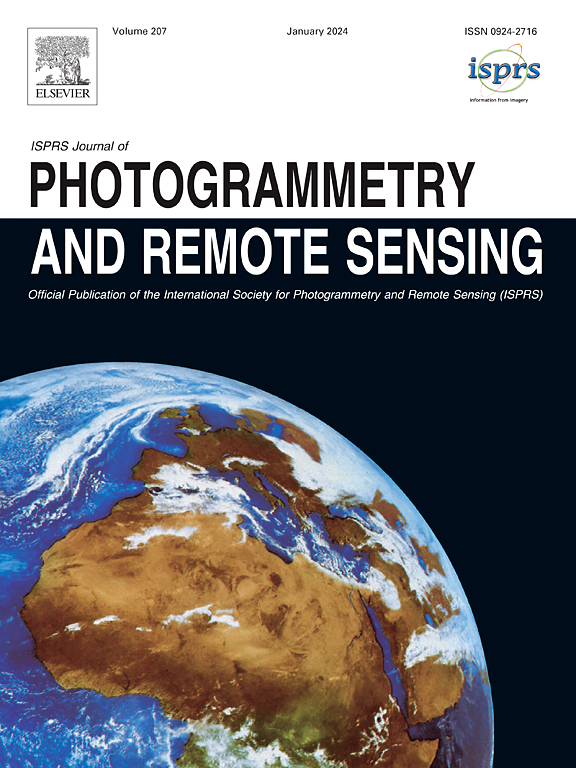A new approach to color correction and equalization for generating mars global color image mosaics from Tianwen-1 MoRIC images
IF 10.6
1区 地球科学
Q1 GEOGRAPHY, PHYSICAL
ISPRS Journal of Photogrammetry and Remote Sensing
Pub Date : 2025-05-08
DOI:10.1016/j.isprsjprs.2025.04.024
引用次数: 0
Abstract
Mars is rich in color information, and color images can more accurately represent the surface morphology of Mars, aiding in the interpretation of its geomorphological and geological characteristics. Obtaining complete, consistent, well-quantified, and intuitive colors of Mars from remote sensing is challenging due to the instrument limitations, varying the illumination and atmospheric conditions, the dynamics of active geomorphology. Moderate Resolution Imaging Camera (MoRIC) and Mars Mineralogical Spectrometer (MMS) onboard the Tianwen-1 orbiter achieved the global coverage of Mars stereo images and the global spectral measurements in the visible and near-infrared bands. However, due to the effects of illumination and atmospheric conditions, there are obvious north–south stripes in the MoRIC color mosaic map, and the overall color tone is significantly reddish. The color difference analysis shows that the color variation in the high-latitude region of the Northern Hemisphere is mainly caused by different atmospheric conditions at the time of imaging, while in the middle and low latitude regions, it is primarily due to varying lighting conditions. In the high-latitude region of the Southern Hemisphere, the color difference is mainly caused by changes in features associated with the seasonal melting of the polar cap. In this work, we used MMS spectral data to establish Martian surface standard colors and presented a novel approach of quantified color correction and equalization for generating Mars global color image mosaics from MoRIC images. This method adjusts the brightness and tone of the images under different imaging conditions to achieve visual consistency and maintain the tonal consistency of similar features globally. The majority (80.1 %) of the overlapping areas with color differences are concentrated in ΔE00 ≤ 3.0, which significantly improves the color and brightness inconsistency of the origin. The final global color mosaics map with a spatial resolution of 76 m shows a “terracotta tone,” which we expect for Mars images, and is a good approximation of what the human eye might see.
一种基于“天文一号”MoRIC图像生成火星全局彩色图像拼接的色彩校正和均衡新方法
火星具有丰富的色彩信息,彩色图像可以更准确地代表火星的表面形态,有助于解释其地貌和地质特征。由于仪器的限制、光照和大气条件的变化以及活跃地貌的动态变化,从遥感中获得完整、一致、良好量化和直观的火星颜色是具有挑战性的。“天文一号”轨道飞行器搭载的中分辨率成像相机(MoRIC)和火星矿物光谱仪(MMS)实现了火星立体图像的全球覆盖以及可见光和近红外波段的全球光谱测量。然而,由于光照和大气条件的影响,MoRIC彩色马赛克图中出现了明显的南北条纹,整体色调明显偏红。色差分析表明,北半球高纬度地区的颜色变化主要是由于成像时不同的大气条件造成的,而中低纬度地区的颜色变化主要是由于光照条件的变化造成的。在南半球高纬度地区,颜色差异主要是由极帽季节性融化相关特征的变化引起的。本文利用MMS光谱数据建立了火星表面标准颜色,并提出了一种新的量化颜色校正和均衡方法,用于从MoRIC图像生成火星全球彩色图像马赛克。该方法通过调整不同成像条件下图像的亮度和色调,达到视觉一致性,并保持全局相似特征的色调一致性。大部分(80.1%)色差重叠区域集中在ΔE00≤3.0,显著改善了原点颜色和亮度的不一致性。最终的全球彩色马赛克地图的空间分辨率为76米,显示了一种“陶土色调”,这是我们对火星图像的预期,是人眼可能看到的很好的近似。
本文章由计算机程序翻译,如有差异,请以英文原文为准。
求助全文
约1分钟内获得全文
求助全文
来源期刊

ISPRS Journal of Photogrammetry and Remote Sensing
工程技术-成像科学与照相技术
CiteScore
21.00
自引率
6.30%
发文量
273
审稿时长
40 days
期刊介绍:
The ISPRS Journal of Photogrammetry and Remote Sensing (P&RS) serves as the official journal of the International Society for Photogrammetry and Remote Sensing (ISPRS). It acts as a platform for scientists and professionals worldwide who are involved in various disciplines that utilize photogrammetry, remote sensing, spatial information systems, computer vision, and related fields. The journal aims to facilitate communication and dissemination of advancements in these disciplines, while also acting as a comprehensive source of reference and archive.
P&RS endeavors to publish high-quality, peer-reviewed research papers that are preferably original and have not been published before. These papers can cover scientific/research, technological development, or application/practical aspects. Additionally, the journal welcomes papers that are based on presentations from ISPRS meetings, as long as they are considered significant contributions to the aforementioned fields.
In particular, P&RS encourages the submission of papers that are of broad scientific interest, showcase innovative applications (especially in emerging fields), have an interdisciplinary focus, discuss topics that have received limited attention in P&RS or related journals, or explore new directions in scientific or professional realms. It is preferred that theoretical papers include practical applications, while papers focusing on systems and applications should include a theoretical background.
 求助内容:
求助内容: 应助结果提醒方式:
应助结果提醒方式:


